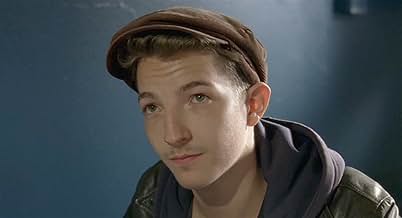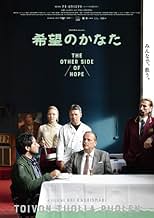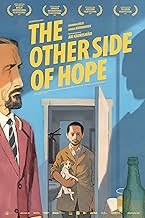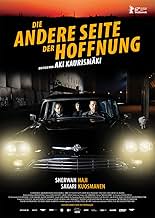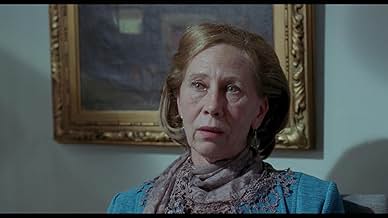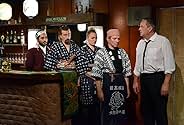IMDb RATING
7.2/10
14K
YOUR RATING
A poker-playing restaurateur and former traveling salesman befriends a group of refugees newly arrived to Finland.A poker-playing restaurateur and former traveling salesman befriends a group of refugees newly arrived to Finland.A poker-playing restaurateur and former traveling salesman befriends a group of refugees newly arrived to Finland.
- Awards
- 8 wins & 24 nominations total
Abdi Jama
- Aseman kassa
- (as Abdi alias 'Lii' Jama)
Simon Al-Bazoon
- Mazdak
- (as Simon Hussein Al-Bazoon)
- Director
- Writer
- All cast & crew
- Production, box office & more at IMDbPro
Featured reviews
Saw this at the Berlinale 2017, where it was part of the official competition for the Golden Bear. The synopsis on the festival website was not really promising, but my prejudice disappeared gradually during the screening. Although the movie has a certain inclination to become a fairy tale where everyone will live happily ever after, the ending has some darker sides to downplay the assumed optimistic story. One of these darker sides lies in the several times appearing "Finland security" men, who are up to no good.
Our first main protagonist Khaled is seeking asylum in Finland. From the outside, it looks like a very clean process as far as shown to us. The idle waiting time related to the asylum application procedure does hide the rough edges we often read about, namely that asylum seekers among themselves are making trouble when seeing others with a different religion or other political position, or even worse when seeing GLBT behavior that they are not prepared to allow. Intolerance can be very problematic here, given that the people are packed together, while at the same time being bored to death, doomed to wait, unable to do anything useful. Due to their numbers and possible variations in asylum seekers, it is a sheer impossible task to sort and separate them in such a way that such troubles are prevented. In this movie, however, the asylum seekers are living harmoniously together, and help each other where they can without seeking favors in return. What does Finland do what we apparently are doing wrong in The Netherlands??
Our second main protagonist Wikström follows a completely different path. On a random morning, he leaves his wedding ring and house keys with his wife, who is clearly alcohol addicted. He sells his stock but keeps the storage space (will become unexpectedly useful later). What also proves useful is his poker face, and he succeeds in multiplying his amount of cash considerably, to the extent that he can buy a restaurant including staff. The capabilities of the restaurant staff that he takes over with the rest of the inventory and furniture, do not look very promising from the outset, but he keeps them nevertheless.
For the first 30 minutes or so, the stories of above two main protagonists run their completely separate course. We see them in turns, both paths clearly delineated, simply by having other people and another decor visible. After his asylum request being denied, and just before being transported to a plane to be sent back, Khaled escapes and starts an uncertain life on the street. He is found sleeping between the trashcans by fresh restaurateur Wikström, from which moment on their lives become mingled.
The restaurant business does not go as well as may be hoped. Given the quality of the staff that he inherited when buying the restaurant, it can be no surprise from the first day on. For example, when someone orders sardines from the menu, that seems to mean that he receives a half opened can. More humor follows later on when they try out different restaurant types, e.g. sushi being prepared out of a cooking book. Other experiments also hardly succeed. A surprise inspection is handled in a way not exactly by-the-book but they pass. These humoristic scenes are intermixed with the more serious main line of the story.
The story includes a series of lucky strikes and happy coincidences that is overwhelming, bordering on statistically impossible. But otherwise there would have been no story to tell, so who am I to complain. The musical fragments we witnessed, most in cafés or restaurants, even one where Khaled plays the sitar (is that the proper name?), albeit not relevant to the story itself, are included (I think) as ornamentation or as local folklore, or simply happened to be available and deemed a waste when left out.
All in all, this movie is much better than what the average synopsis promises. On the other hand, it is not easy to describe what it is exactly that makes the movie attractive. The serious undertone cannot be overlooked, given the hostilities encountered by Khaled, and the motivation for the denial of his asylum request is also a farce, based on wrong facts that we see refuted on TV, and gives Finland a bad name. However, the parallel story with Wikström and his restaurant takes good care of ample relief from the heavy material. I usually lower my expectations when a book or movie builds on two or more parallel story lines, by assuming that none of the stories could offer sufficient material to stand on its own feet, but this time my prejudice proved unjustified. The way both stories were mixed without disturbing the logical flow of events, may be one of the reasons this movie was awarded by the International Jury of the Berlinale 2017.
Our first main protagonist Khaled is seeking asylum in Finland. From the outside, it looks like a very clean process as far as shown to us. The idle waiting time related to the asylum application procedure does hide the rough edges we often read about, namely that asylum seekers among themselves are making trouble when seeing others with a different religion or other political position, or even worse when seeing GLBT behavior that they are not prepared to allow. Intolerance can be very problematic here, given that the people are packed together, while at the same time being bored to death, doomed to wait, unable to do anything useful. Due to their numbers and possible variations in asylum seekers, it is a sheer impossible task to sort and separate them in such a way that such troubles are prevented. In this movie, however, the asylum seekers are living harmoniously together, and help each other where they can without seeking favors in return. What does Finland do what we apparently are doing wrong in The Netherlands??
Our second main protagonist Wikström follows a completely different path. On a random morning, he leaves his wedding ring and house keys with his wife, who is clearly alcohol addicted. He sells his stock but keeps the storage space (will become unexpectedly useful later). What also proves useful is his poker face, and he succeeds in multiplying his amount of cash considerably, to the extent that he can buy a restaurant including staff. The capabilities of the restaurant staff that he takes over with the rest of the inventory and furniture, do not look very promising from the outset, but he keeps them nevertheless.
For the first 30 minutes or so, the stories of above two main protagonists run their completely separate course. We see them in turns, both paths clearly delineated, simply by having other people and another decor visible. After his asylum request being denied, and just before being transported to a plane to be sent back, Khaled escapes and starts an uncertain life on the street. He is found sleeping between the trashcans by fresh restaurateur Wikström, from which moment on their lives become mingled.
The restaurant business does not go as well as may be hoped. Given the quality of the staff that he inherited when buying the restaurant, it can be no surprise from the first day on. For example, when someone orders sardines from the menu, that seems to mean that he receives a half opened can. More humor follows later on when they try out different restaurant types, e.g. sushi being prepared out of a cooking book. Other experiments also hardly succeed. A surprise inspection is handled in a way not exactly by-the-book but they pass. These humoristic scenes are intermixed with the more serious main line of the story.
The story includes a series of lucky strikes and happy coincidences that is overwhelming, bordering on statistically impossible. But otherwise there would have been no story to tell, so who am I to complain. The musical fragments we witnessed, most in cafés or restaurants, even one where Khaled plays the sitar (is that the proper name?), albeit not relevant to the story itself, are included (I think) as ornamentation or as local folklore, or simply happened to be available and deemed a waste when left out.
All in all, this movie is much better than what the average synopsis promises. On the other hand, it is not easy to describe what it is exactly that makes the movie attractive. The serious undertone cannot be overlooked, given the hostilities encountered by Khaled, and the motivation for the denial of his asylum request is also a farce, based on wrong facts that we see refuted on TV, and gives Finland a bad name. However, the parallel story with Wikström and his restaurant takes good care of ample relief from the heavy material. I usually lower my expectations when a book or movie builds on two or more parallel story lines, by assuming that none of the stories could offer sufficient material to stand on its own feet, but this time my prejudice proved unjustified. The way both stories were mixed without disturbing the logical flow of events, may be one of the reasons this movie was awarded by the International Jury of the Berlinale 2017.
Aki Kaurismäki's film 'The Other Side of Hope' is really two films in one: the first, a deadly serious look at the life of a Syrain refugee in Finland, and the other, a deadpan comic look at the escapades of an unlikely restauranteur. Oddly, it works, with its direct abutment of light and shade, and its playful treatment of the legendary Finish characteristic of taciturnity. A nice element of the movie is it's use of music as a symbol of our common humanity. It's a simple film, but I liked it.
Finnish director, Aki Kaurismäki has successfully established himself as a respectable auteur in world cinema. When it was announced after the release of Kaurismäki's last film "Le Havre" (2011) that it would be followed by another film covering similar topics and themes, audiences have been anxiously waiting for his next effort. Thus, six years later, comes "The Other Side of Hope" (2017, "Beyond Hope" literally), a film that Kaurismäki wanted to get out before it was too late. One should not be surprised by such openness about the film's political agenda given Kaurismäki's usual tendencies to do so. Nor should one be surprised by the fact that "The Other Side of Hope" is everything one could expect from Kaurismäki: an immediately recognizable film belonging to the canon of his oeuvre. While some Finnish critics have been disappointed by the lack of innovation or regeneration from Kaurismäki, they have failed to appreciate that often the best artists keep doing the "same" over and over again -- think of Ozu and Hawks, for instance, both of whom Kaurismäki adores tremendously.
Like "Le Havre", "The Other Side of Hope" also tells the story about a refugee encountering a European local. The small port town of Le Havre in France has been changed to Helsinki in Finland and the North-African refugee to a Syrian. The film follows Khaled's (played by Sherwan Haji) day- to-day activities in the red tape of immigration policy, his attempts to track down his lost sister, and his conflicts with locals as well as a parallel story about a Finnish man (played by Kaurismäki regular Sakari Kuosmanen) who leaves his wife and starts up a restaurant which eventually leads him to meet Khaled.
As mentioned above, one can recognize the film as Kaurismäki's instantly. The cinematography is often static by nature (even camera movement is rather mechanic), the acting is deadpan and the actors' delivery is laconic to the bone, there is nostalgic popular music, and mise-en-scène is characterized by vintage elements from old cars to type writers as well as classic Hollywood lighting. These cinematic means often give an ironic impression which, nonetheless, never reduces the film to a parody of itself; it manages to take itself seriously while joking around, so to speak. They also constitute an extremely economic narrative where a wordless act such as the placing of a ring on a kitchen table can say more than a thousand words. In terms of tone, Kaurismäki's film lies securely in between of tragedy and comedy, cynicism and humanism, melancholy and laughter.
In this world of deep contradictions -- not only in tone, of course, but also in, say, the co- existence of vintage elements in mise-en-scène with modern technology -- Kaurismäki's characters often find themselves to be strangers. They are strangers essentially in two senses. First, they are strangers of society; they are thugs, loners, divorced, unemployed, homeless, and refugees. Second, they are strangers of existence; their being in the world is twisted in the sense that they talk absurdly little, do not notice the absurdities of the fictive world with its contradictions, stand still for long periods of time, and can suddenly announce that they will move to Mexico City for a change of scenery without giving rise to any trace of astonishment in their interlocutors.
It seems to me that Kaurismäki's phenomenology of strangeness, if I may give it such a hasty word, has gained significant new dimensions in his contemporary cinema of global ethics. The strangers of "The Other Side of Hope" find comrades in each other without a need to announce it. They are the global working class with no nation. They are a plural bunch whose shared humanity overcomes individual differences. In a key scene echoing "Le Havre", there is a moving montage of human faces as the refugees in the reception center listen to a wordless ballad by Khaled. It is a very Kaurismäki-esque moment of cinematic personality, but here the strangeness seems to articulate heavily moral meanings in particular.
While the film is unapologetically moral and political in its message and agenda, it also comes across as a good piece of cinema with a poetry all its own (that is, the cinematic poetry of Kaurismäki's cinema in general, to be precise). Like many other films by Kaurismäki, sea is an essential element, which might represent the film's success in finding a place between poetry and politics. "The Other Side of Hope" begins with a beautiful shot of the Baltic Sea. To Peter von Bagh, a Finnish film critic and historian, all cinematic images of sea are masterful. The beauty of the sea is easily captured in a way which makes everyone a master. Yet, in order for us to care about these images, something has to happen -- either in terms of story, theme, or aesthetics -- in their appropriate contexts. In this sense, Kaurismäki delivers. The other side of hope, or its vague image in the world beyond, finds its elusive face on the surface of the sea. When Peter von Bagh passed away in 2014, Kaurismäki promised to dedicate his next film to von Bagh's memory, adding that "only if it is good enough." He did.
Like "Le Havre", "The Other Side of Hope" also tells the story about a refugee encountering a European local. The small port town of Le Havre in France has been changed to Helsinki in Finland and the North-African refugee to a Syrian. The film follows Khaled's (played by Sherwan Haji) day- to-day activities in the red tape of immigration policy, his attempts to track down his lost sister, and his conflicts with locals as well as a parallel story about a Finnish man (played by Kaurismäki regular Sakari Kuosmanen) who leaves his wife and starts up a restaurant which eventually leads him to meet Khaled.
As mentioned above, one can recognize the film as Kaurismäki's instantly. The cinematography is often static by nature (even camera movement is rather mechanic), the acting is deadpan and the actors' delivery is laconic to the bone, there is nostalgic popular music, and mise-en-scène is characterized by vintage elements from old cars to type writers as well as classic Hollywood lighting. These cinematic means often give an ironic impression which, nonetheless, never reduces the film to a parody of itself; it manages to take itself seriously while joking around, so to speak. They also constitute an extremely economic narrative where a wordless act such as the placing of a ring on a kitchen table can say more than a thousand words. In terms of tone, Kaurismäki's film lies securely in between of tragedy and comedy, cynicism and humanism, melancholy and laughter.
In this world of deep contradictions -- not only in tone, of course, but also in, say, the co- existence of vintage elements in mise-en-scène with modern technology -- Kaurismäki's characters often find themselves to be strangers. They are strangers essentially in two senses. First, they are strangers of society; they are thugs, loners, divorced, unemployed, homeless, and refugees. Second, they are strangers of existence; their being in the world is twisted in the sense that they talk absurdly little, do not notice the absurdities of the fictive world with its contradictions, stand still for long periods of time, and can suddenly announce that they will move to Mexico City for a change of scenery without giving rise to any trace of astonishment in their interlocutors.
It seems to me that Kaurismäki's phenomenology of strangeness, if I may give it such a hasty word, has gained significant new dimensions in his contemporary cinema of global ethics. The strangers of "The Other Side of Hope" find comrades in each other without a need to announce it. They are the global working class with no nation. They are a plural bunch whose shared humanity overcomes individual differences. In a key scene echoing "Le Havre", there is a moving montage of human faces as the refugees in the reception center listen to a wordless ballad by Khaled. It is a very Kaurismäki-esque moment of cinematic personality, but here the strangeness seems to articulate heavily moral meanings in particular.
While the film is unapologetically moral and political in its message and agenda, it also comes across as a good piece of cinema with a poetry all its own (that is, the cinematic poetry of Kaurismäki's cinema in general, to be precise). Like many other films by Kaurismäki, sea is an essential element, which might represent the film's success in finding a place between poetry and politics. "The Other Side of Hope" begins with a beautiful shot of the Baltic Sea. To Peter von Bagh, a Finnish film critic and historian, all cinematic images of sea are masterful. The beauty of the sea is easily captured in a way which makes everyone a master. Yet, in order for us to care about these images, something has to happen -- either in terms of story, theme, or aesthetics -- in their appropriate contexts. In this sense, Kaurismäki delivers. The other side of hope, or its vague image in the world beyond, finds its elusive face on the surface of the sea. When Peter von Bagh passed away in 2014, Kaurismäki promised to dedicate his next film to von Bagh's memory, adding that "only if it is good enough." He did.
In modern-day Helsinki, the lives of two characters are followed: Waldemar (Sakari Kuosmanen) is beginning a new life as a single man and opening a new restaurant; and Khaled (Sherwan Haji) is a refugee from Allepo, Syria seeking asylum in Finland.
This film deserves credit for taking on a subject that continues to grab headlines and personalizes it. The Finns in this movie are mostly portrayed as generous and fair-minded with a few exceptions: some are seen as idiotic government bureaucrats (an international problem), and others are seen as downright nasty thugs (a bigger international problem).
The directing style by Aki Kaurismaki is in his usual style of being deliberately austere and distant with moments of dry humour. It works well mostly but there could have been room for a few moments of deeper emotion considering the subject matter.
A shocking twist at the end does give the film some jolt but the ambiguity of the situation (which is also far-fetched to a degree) is unsatisfying. Despite this, "The Other Side of Hope" is a fine film. As it focuses mostly on Khaled, Haji comes off as a very fine anchor for the movie. - dbamateurcritic
This film deserves credit for taking on a subject that continues to grab headlines and personalizes it. The Finns in this movie are mostly portrayed as generous and fair-minded with a few exceptions: some are seen as idiotic government bureaucrats (an international problem), and others are seen as downright nasty thugs (a bigger international problem).
The directing style by Aki Kaurismaki is in his usual style of being deliberately austere and distant with moments of dry humour. It works well mostly but there could have been room for a few moments of deeper emotion considering the subject matter.
A shocking twist at the end does give the film some jolt but the ambiguity of the situation (which is also far-fetched to a degree) is unsatisfying. Despite this, "The Other Side of Hope" is a fine film. As it focuses mostly on Khaled, Haji comes off as a very fine anchor for the movie. - dbamateurcritic
Remember the pretty boy Ronan Keating singing that you say it best when you say nothing at all? Of course you don't, you only listen to good music. But this could be the very motto of Finnish legendary moviemaker Aki Kaurismäki's latest. This minimalist masterpiece is so achingly simple and elegant and yet so complex in a good way, that there's no really good way to describe it, if you don't understand Kaurismäki's style already. Toivon tuolla puolen" (The Other Side of Hope" in English, Teispool lootust" in Estonian") is like a haiku: it can convey so much with so little words and even so little action. I can't find fitting comparisions here, but Kaurismäki comes across like Jim Jarmusch's less snobish cousin: even more concentrated on what it's like to be human and small things that life is actually made of. They both value storytelling through details but Kaurismäki's approach is more mainstreamfriendly: you don't have to invest yourself fully all the time to make sense of what's going on exactly. Toivon tuolla puolen" offers two bittersweet stories interwining, about refugee in strange and hostile land and old entrepreneur who leaves his wife and finds fresh start in running a diner. It often feels like comedy – Kaurismäki's approach could be called Finnish version of Soviet nostalgia that many 30-year or older viewers will respond to and enjoy. Judging by Estonian premiere, it's a real crowdpleaser. But deeper down it's more about bleak and sad side of human existence: loneliness, being unwanted, trying to find purpose when everything has fallen down. And, of course, about how there's no winning with nowadays' refugee crisis – it brings suffering for everyone involved, except for maybe those who like to attack people who shouldn't be here". I give this quietly hilarious and heartbreaking masterpiece a near- perfect score. Although it doesn't break new grounds for Kaurismäki, I can't think of a way how it could be improved in any meaningful way. The movie's not gonna satisfy everybody, nothing will, but it's almost perfect the way it is. Deceptively simple but powerful experience that you can't imagine getting from anybody else than Kaurismäki.
Did you know
- TriviaThe actors playing siblings Khaled and Miriam are real-life siblings.
- ConnectionsFeatured in Ismo Haavisto One Man Band: Midnight Man (2017)
- SoundtracksOi mutsi, mutsi
Written and performed by Tuomari Nurmio
- How long is The Other Side of Hope?Powered by Alexa
Details
- Release date
- Countries of origin
- Official sites
- Languages
- Also known as
- The Other Side of Hope
- Filming locations
- Helsinki, Finland(The city)
- Production companies
- See more company credits at IMDbPro
Box office
- Budget
- €1,600,000 (estimated)
- Gross US & Canada
- $183,943
- Opening weekend US & Canada
- $15,495
- Dec 3, 2017
- Gross worldwide
- $4,282,973
- Runtime1 hour 40 minutes
- Color
- Sound mix
- Aspect ratio
- 1.85 : 1
Contribute to this page
Suggest an edit or add missing content

Top Gap
By what name was L'autre côté de l'espoir (2017) officially released in India in English?
Answer

